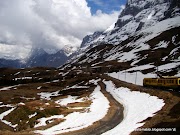Ha valaki megtudja, hogy mennyi helyen jártam már, szinte biztosan az az első kérdése, hogy mi a kedvenc helyem, illetve mi a legnagyobb látványosság. Ezen mindig elgondolkodom, mégsem tudok rendes választ adni, mert rengeteg helyet szeretek valamiért nagyon: Olaszországot sok más mellett az ételek és a nyelv miatt, Norvégiát, Svájcot vagy Montenegrót a természetért, Hollandiát a rendezettségéért, Japánt a semmihez nem hasonlítható egyediségéért és így tovább. Azt viszont több mint 80 ország, valamint a Taj Mahal, Angkor, a Nagy Fal, a Machu Picchu, a gízai piramisok, az Alhambra és még pár hasonló kaliberű hely felkeresése után is biztosan merem állítani, hogy a világ talán legnagyobb csodája Mianmarban (leánykori nevén Burma) van és úgy hívják, Bagan.
If anyone learns how many places I've been to already, their first question will invariably be about what my favorite place is or what the greatest sight is. This always makes me think but I can never give a straight answer because there are many places I love for something: Italy, among many things, for its food and language; Norway, Switzerland or Montenegro for its nature; the Netherlands for its tidiness, Japan for its incomparable uniqueness and so on. However, I do know, after having visited more than 80 countries and places like the Taj Mahal, Angkor, the Great Wall, Machu Picchu, the pyramids of Giza, the Alhambra and some more sights of similar caliber, that probably the biggest wonder of the world is in Myanmar (formerly Burma) and is called Bagan.
 |
| Egyrészt hihetetlen 200 év alatt ennyi templomot építeni (rengeteg rabszolga kellett hozzá), másrészt azért két évszázad mégis hosszú idő, így a templomok építészeti stílusai közt is nagy különbségek vannak és szerettünk volna párat alaposabban is megnézni, úgyhogy bele kellett húzni. Végül két nap alatt 15 templomot jártunk végig: a leghíresebbek kivételével csak kevés turistával találkoztunk, mert a több évtizedes katonai diktatúra és elszigeteltség után Mianmart még csak most kezdik felfedezni a külföldiek: Angkorba évente több mint 2 millióan látogatnak el, ide egyelőre kb. tizedannyian, de ez biztos, hogy rövidesen meg fog változni. Vajon pár év múlva is lehet itt ilyen képet készíteni, ahol a földúton sétáló fiatal szerzetes néz vissza a templomra, vagy már szuvenírboltokkal szegélyezett aszfaltút lesz itt? One the one hand, it's incredible to build so many temples in 200 years (it took a lot of slaves). However, two centuries is a long time, so there are big differences between the architectural styles of the temples and we wanted to check out some of them in more detail, so we had to get going. We eventually made it to 15 temples in 2 days: once away from the most famous temples, we saw very few tourists as Myanmar is still being discovered by foreigners after decades of military dictatorship and isolation. While more than 2 million people visit Angkor in a year, the figure is still about one-tenth here for the time being. I'm pretty sure it's about to change soon and I wonder if such a photo of a solitary young monk walking along a dirt track and looking back on the temple can be taken in a few years or will there be a paved road here lined by souvenir stalls? |
 |
| Magányos imádkozó késő délután a Sin Myar Shin templomnál. Solitary late afternoon prayer in the Sin Myar Shin temple. |
 |
| Gawdawpalin, a második legnagyobb templom esti kivilágításban. Gawdawpalin, the second largest temple, in its evening illumination. |
 |
| Ezen a blogon nem szoktam magamat mutatni, de ez egy nagyon kedves képem, amit a lakásunk falára is kitettünk bekeretezve: a mai napig egyik legszebb utazási emlékünk ez a nap, ahogy elektromos robogóval reggeltől estig róttuk a poros utakat egyik gyönyörű ősi templomtól a másikig. I don't usually show myself on this blog but this is a photo I'm particularly fond of and we even have it framed and hung on the wall in our apartment: this day that we spent riding on dusty roads with our electric scooter from one incredible ancient temple to another continues to be one of our greatest travel memories. |
 |
| Dhammayangyi, az összes bagani templom legnagyobbika Dhammayangyi, the largest of all the temples in Bagan |
 |
| Sehol egy ház, sehol egy autóút: ez a látkép 800 évvel ezelőtt is hasonló lehetett. A house or a highway is nowhere to be seen: this view is likely to have been similar 800 years ago too. |
 |
| Az aranyozott tetejű sztúpákkal díszített Dammayazika templom 1196-ból. The Dammayazika temple with its gilded stupas dates from 1196. |
 |
| Keretbe foglalva az itt töltött két napot visszatértünk a Shwesandaw Pagoda tetejére, ahonnan előző nap hajnalban először megláttuk Bagant. Nehéz volt rábírni magunkat, hogy továbbmenjünk és biztos vagyok benne, hogy ide még visszatérünk, bár kérdés, mi minden változik majd addigra. Nekünk az egyik kedvenc dolgunk például az volt, hogy felmásztunk a templomok tetejére, amit most már nem lehet megtenni: nekünk még csak annyi volt a szabály, hogy szigorúan mezitláb lehet felmenni, így mindig jó koszosak voltunk, de egyáltalán nem zavart. Pár hónapja viszont a legtöbb templomra már egyáltalán nem szabad felmenni. We ended our two-day Bagan trip where we started: on the top of Shwesandaw Pagoda. It was hard to leave this place and we're sure we will return, though it's a big question what will have changed by then. One of our favorite things to do was climbing temples, something you can't do anymore: the only rule for us was that you had to be strictly barefoot so we were dirty all the time but we really didn't care. Then a few months ago climbing was banned almost everywhere. |










